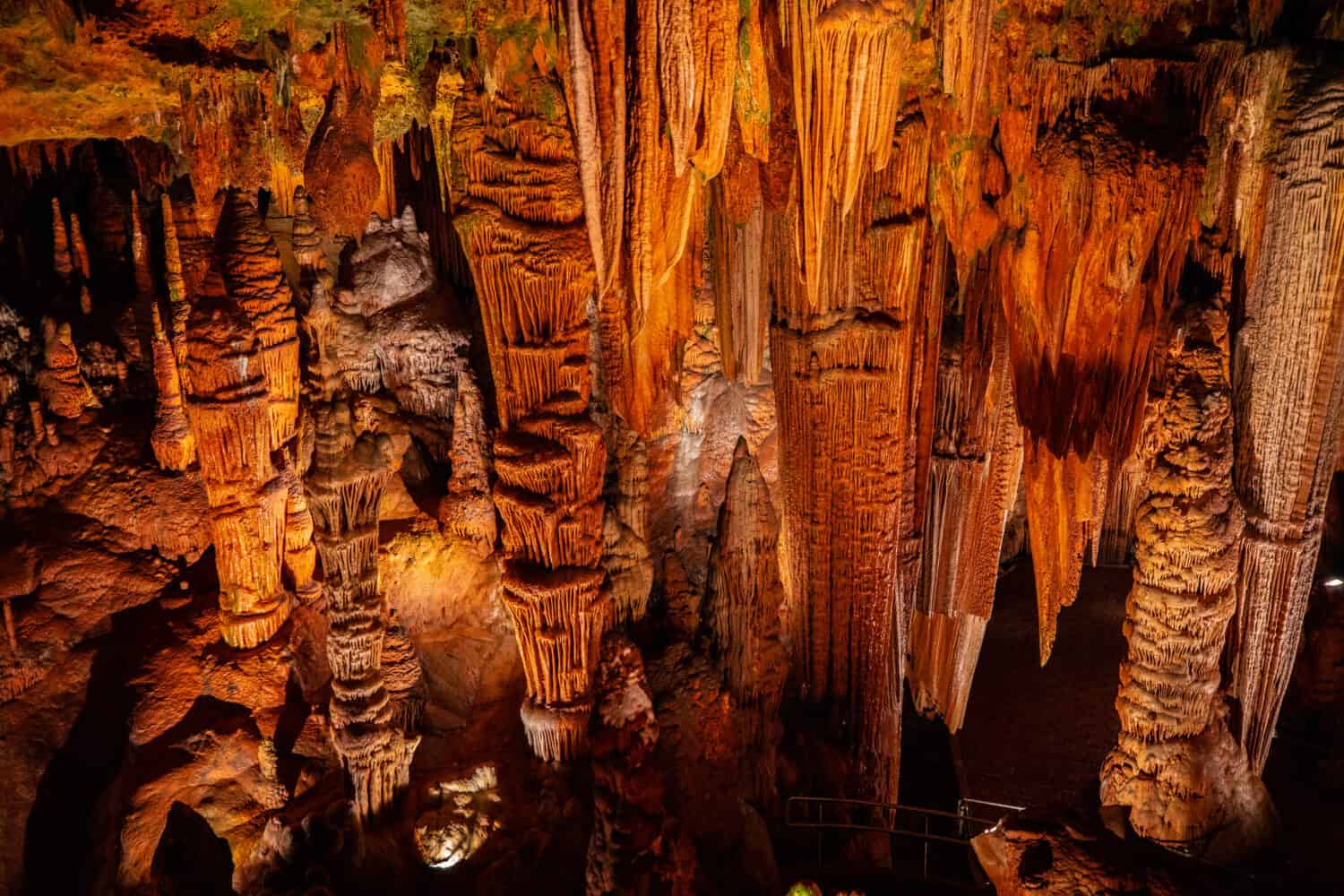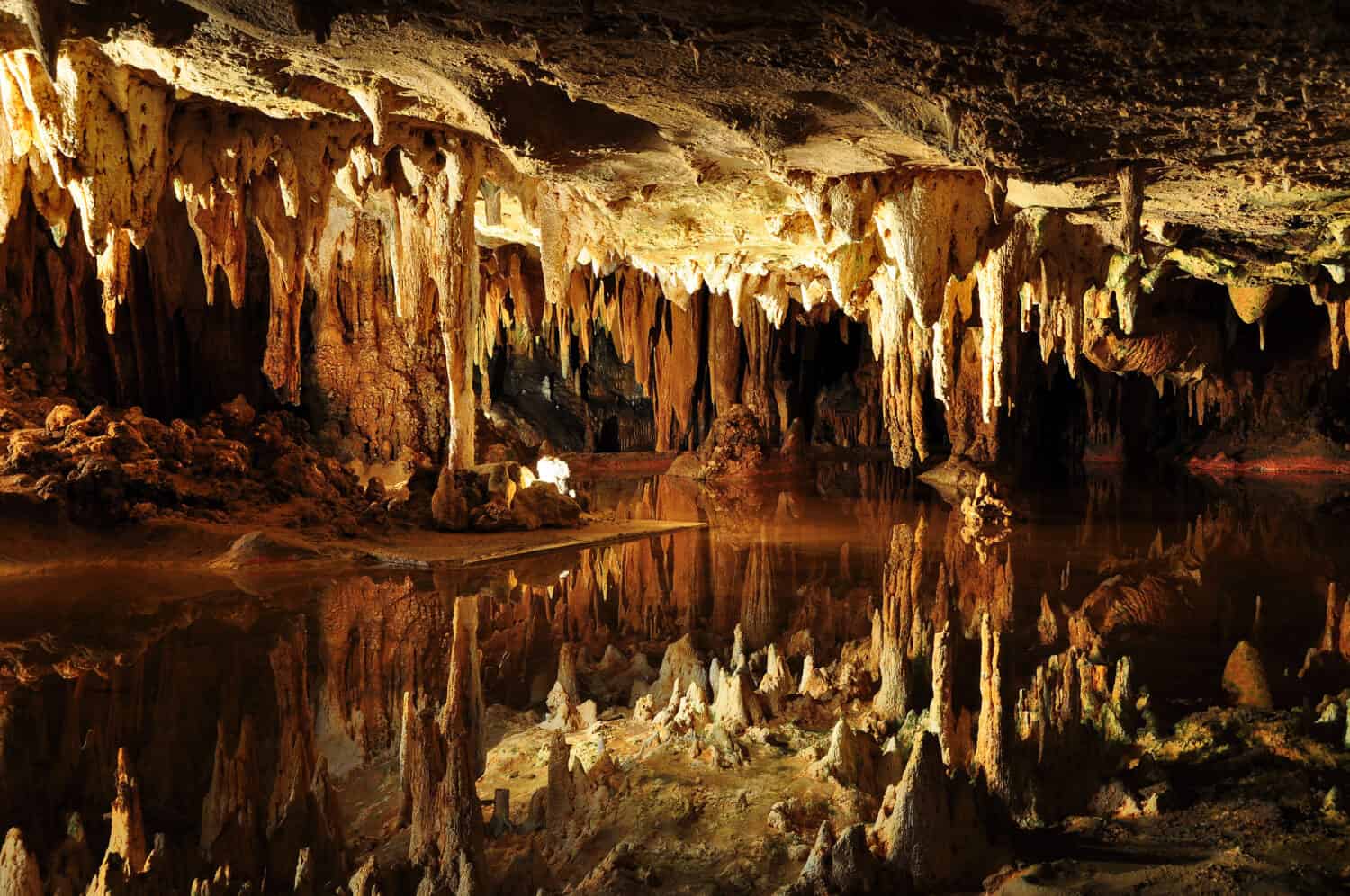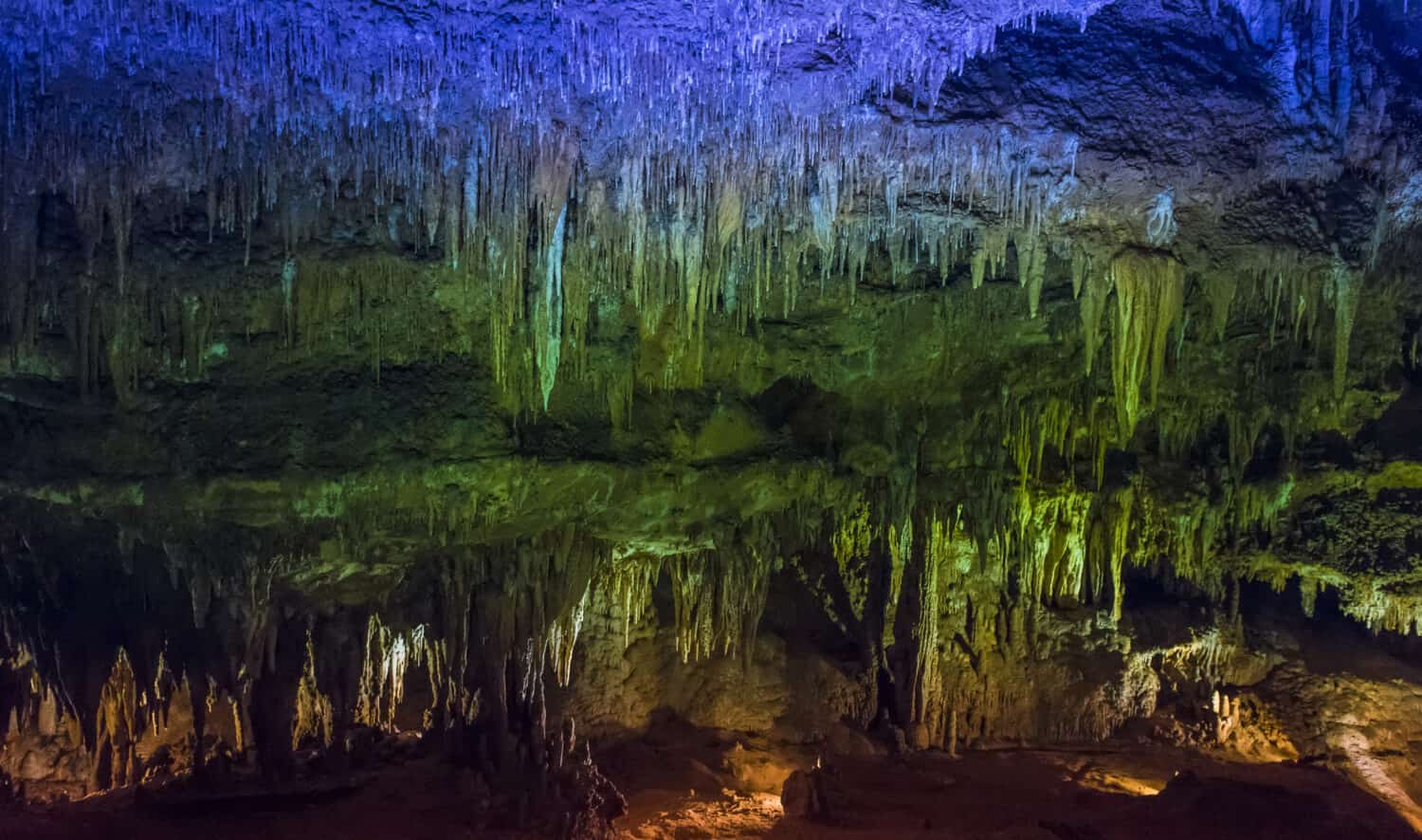The Luray Caverns is a U.S. Natural Landmark that you can find below Virginia‘s Blue Ridge Mountains. This natural wonder has been explored by tourists for its breathtaking geological features and interesting history. The vast cave system consists of interconnecting passageways and lakes underground that will mesmerize all its visitors. Join me on this adventure as we explore the Luray Caverns and what lurks inside these massive Virginia caves. An adventure awaits you!
What Are the Luray Caverns?
Firstly, is there a difference between a cavern and a cave? Technically, they are the same thing. Caverns are normally deeper and larger than caves and grow speleothems. Lurey Caverns began developing 400 million years ago, showcasing enormous chambers covering 64 acres. The cavern was formed from underground rivers and layers of clay and limestone. As the clay began to wash away, large limestone openings were exposed. The stalagmites and stalactites were formed due to the mineral-laden water that dripped from the cave’s ceilings, walls, and floors. This limestone cavern is in Page County, northwestern Virginia, and is the largest in the eastern United States.
The large chambers of the cavern are 30 to 140 feet high, with interconnecting corridors and bridges. There are two crystal clear bodies of water: the Silver Sea and Dream Lake. The 10-story high ceilings in each cavern room are adorned with stalactites, and the stalagmites protruding from the cavern floor create beautiful bridges and walkways. Now a federal natural landmark, the Luray Caverns is a must-see for all travelers heading to the Old Dominion state!

The Luray Caverns were developed over the last 400 million years.
©jgorzynik/Shutterstock.com
History of the Luray Caverns
The deep, dark caves in Luray are filled with history and mystery. The caverns developed over millions of years, with new deposits taking 120 years just to develop one cubic inch of new deposits. Long before the discovery of the Lurey Caverns by the local men, evidence suggests Native Americans used the caves. Human remains, flint, and other artifacts were found embedded in the stalagmite. There is a skeleton of what is believed to be a Native American girl that’s around 500 years old found in a chasm.
Benton Pixley Stebbins discovered the caverns in 1878 when he found a sinkhole expelling cold air that appeared to be an entrance to a cave underground. Along with William Campbell, Andrew J. Cambell, John “Quint” Cambell, and photographer Benton Stebbins, the men began digging around the sinkhole until there was enough room for the smallest men to squeeze through and see what was below. The team lowered Andrew and Quint into the hole and, with a candle, saw incredible limestone structures in a large chamber. The men knew that if they could find something exceptional, it could make them rich. Along with his business partner Andrew Cambell, Stebbins purchased the property. This purchase was overruled by the Supreme Court of Virginia and nullified the purchase in 1881 because they kept their knowledge of the cave a secret.

The Luray Caverns cover 64 acres and consist of chambers with tall ceilings, columns, stairways, bridges, and two bodies of water.
©Aleksei Velizhanin/Shutterstock.com
Luray Caverns Opens to the Public
The caverns weren’t open to the public, but rumors began to spread about how big and magnificent they were. Scientists working with the Smithsonian had only high praises for the caves, and professional travel writers, such as Alexander J. Brand Jr. with the New York Times, spread the word of this natural wonder.
Today, the Graves family owns the Luray Caverns. The family’s great-grandfather, Theodore Clay Northcott, purchased the land in 1905. Since its discovery, millions of tourists have walked through the caverns to marvel at the limestone cathedral-like ceilings and structures. Between the optical illusions at Dream Lake and the stalactite organ, the unique experiences at Luray Caverns will satisfy your need for adventure.
These adorned limestone caves cover around 64 acres, and the property accommodates the influx of tourists. There are insightful guided tours, restaurants, a 3-acre museum complex, a toy store, and much more activities and centers to explore.
Geology and Geography of the Luray Caverns
The Luray Caverns have 30 to 40 feet high chambers filled with stalactite columns, icicle-like travertine, and clear pools. The caves’ well-lit, paved passageways, stairways, and bridges will lead you to breathtaking large halls with ten-story ceilings as you explore them. In addition, you can enjoy the constant indoor temperature of 54° F!

A column or pillar is formed when a stalactite and stalagmite meet.
©Mia2you/Shutterstock.com
But how did the caverns form?
The Luray Caverns are limestone caves that took millions of years to form. Underground rivers and water seeped through the ground with acid through the various layers of clay and limestone. Over time, only a limestone shell remained as the clay washed away.
The caverns formed and developed stalactites, which originated from dripping limewater. Mixed with acid, glacial mud filled the caverns, changing their shape and eroding the dripstone.
Water washed the mud away, leaving new growth amongst the older eroded forms, forming stalagmites, stalactites, cascades, and columns.
The stalactites drip from the cavern’s ceiling while the stalagmites rise from the ground, leaving visitors in awe of the beauty surrounding them. When a stalactite meets a stalagmite, a column forms.

Two bodies of water are found in Luray Caverns: Silver Sea and Dream Lake (pictured).
©Joe Ravi/Shutterstock.com
What Lurks Inside the Luray Caverns
At the entrance to the caverns is the Luray Singing Tower. It’s 117 feet high and has 47 bells ringing, weighing 12,5 to 7,640 pounds each. The first column you see is the Washington Column, which honors George Washington, the first U.S. President.
Inside the Luray Caverns, you will find the Great Stalacpipe Organ. The Great Stalacpipe Organ, the largest musical instrument in the world, covers an area of over 3,5 acres! This man-made phenomenon plays the stalactites to create the eerie sounds of the “singing” rocks. Designed and made by Leland W. Sprinkle in the 1950s, the organ has no pipes and has a four-keyboard console, having already played 15,000 times!
When exploring the majestic Luray Caverns, you will come across Dream Lake, a subterranean pool. This crystal-clear body of water is 18 to 20 inches deep and 2,500 square feet. Because the water gives the illusion that it’s still, you can see the beauty of your surroundings reflected in it, creating the illusion of a lake.
You will encounter Giant’s Hall as you walk further into the caverns. Giant’s Hall is a massive chamber with very high ceilings and large columns, up to 10 stories tall. This chamber is so large and majestic, prepare to feel the emotions flood your body.

The Great Stalacpipe Organ is the largest musical instrument in the world.
©Joe Ravi/Shutterstock.com
Across from Giant’s Hall is Saracen’s Tent. Icicle-like formations hang from the ceiling, creating a mesmerizing sight that you will remember forever.
No traditional animals like bats live in the caverns, as the caverns were sealed for millennia. However, many algae species thrive in the caverns, and you may hear about microscopic organisms.
Other Attractions
There are several other attractions available on Luray Cavern’s site.
- The Car and Carriage Caravan Museum: The museum showcases vintage vehicles, such as coaches, carriages, and old automobiles. This collection has over 140 items dating back to 1725 to 1941.
- The Garden Maze: Treat yourself to another adventure inside the largest hedge maze (1 acre) in the Mid-Atlantic. There are more than 1,500 hedges in the maze for you to lose yourself in!
- Toy Town Junction: This museum is home to a huge toy collection donated by a boy who grew up loving toys. It started with his first toy train set he received at age five in 1941. He donated his entire toy collection to the museum as an adult!
- Rope Adventure Park: If you’re still feeling adventurous, take you and your family on either the Low Ropes Course or the High Ropes Course. You will cross over rope bridges and beams in the air.
- Stonyman Mining Company Gem Sluice: The gem sluice is an educational activity where your kids can pan for gemstones while learning about history and geology.
- Restaurants: Sit down and relax with a meal and drink at one of the two restaurants on-site, the Stalactite Cafe and the Heartpine Café.
- Gift Shop: Shop for souvenirs to remember your day.
Visiting the Luray Caverns
Offer practical advice for visitors who want to explore Luray Caverns, including information on tours, hours of operation, and other activities available in the park.
The best way to visit the Luray Caverns is by reserving a ticket online at the official website, www.luraycaverns.com. Purchase tickets on-site, and they rarely sell out, so spontaneous adventures are welcomed! The duration of the tour is about 2 to 3 hours long.

The different types of lighting create colorful hues across the cavern walls and ceiling.
©Anna Krivitskaya/Shutterstock.com
Two tours are available:
- Regular Tour: The Regular Tour includes general admission to the Luray Caverns, Car & Carriage Caravan Museum, Shenandoah Heritage Village, and Toy Town Junction.
- Special Discovery Tour: An 1870s tour guide will take you on a tour of Luray Caverns, teaching you its history. You will also get a copy of a booklet titled “The Story of Luray Caverns.” In addition, you will get a special souvenir voucher and free access to Car & Carriage Caravan Museum, Shenandoah Heritage Village, and Toy Town Junction.
The pricing for the Regular Tour is as follows:
- Adults – $32
- Children (6 to 12 years) – $16
- Seniors – $29
Admission times run every day from 09:00 to 17:00, every 20 minutes. Your ticket is valid for 12 months from the purchase date and is non-refundable.
The pricing for the Special Discovery Tour is as follows:
- Adults – $60
- Children (6 to 12 years) – $30
Only one time is available per day for the Special Discovery Tour, which is at 08:30.
Thank you for reading! Have some feedback for us? Contact the AZ Animals editorial team.








